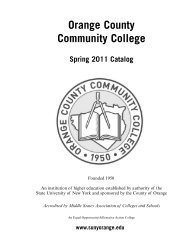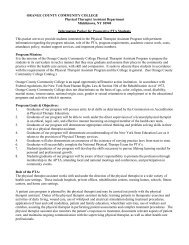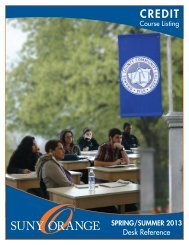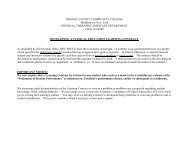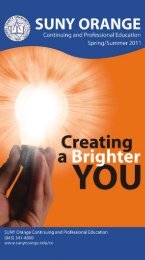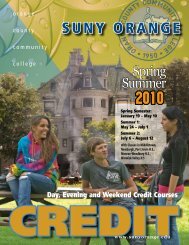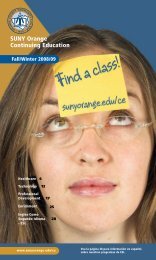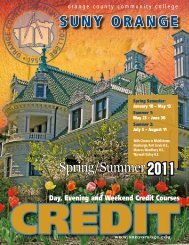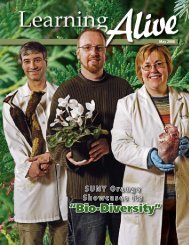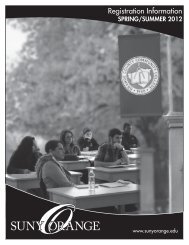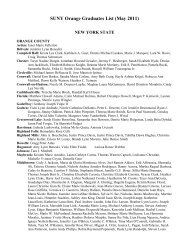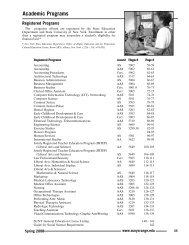Create successful ePaper yourself
Turn your PDF publications into a flip-book with our unique Google optimized e-Paper software.
Mathematics - Medical Laboratory Technology<br />
functions and hyperbolics, the area of a region<br />
between two curves, solids of revolution, application<br />
problems, integration, Trapezoidal rule, Simpson's<br />
Rule, L'Hopital's Rule, Taylor and Maclaurin<br />
polynomials, sequences and series, and power series,.<br />
Prerequisite: C or better in MAT 205<br />
MAT 207—Calculus 3<br />
4 cr. (Fall/Spring evening)<br />
Covers three areas of discourse: vector analysis,<br />
partial differentiation and multiple integration. The<br />
study of vectors includes conic sections, analysis of<br />
vectors in two and three space as well as their<br />
development as vector functions. Partial<br />
differentiation includes such topics as directional<br />
derivatives, gradients, tangent planes, surface<br />
extremes, and exact differentials. Multiple integration<br />
is used for volumes, surface area, moments, Green's<br />
theorem and line integrals.<br />
Prerequisite: C or better in MAT 206<br />
MAT 211—Linear Algebra<br />
3 cr. (Fall/Summer)<br />
Designed primarily for students planning to<br />
specialize in mathematics, computer science, or<br />
engineering. Topics include: vectors in R 2 and R 3<br />
systems of linear equations, determinants and<br />
matrices, vector spaces, linear independence and basis,<br />
linear transformations, eigenvalues and eigenvectors,<br />
and diagonalizations.<br />
Prerequisite: C or better in MAT 205<br />
MAT 214—Differential Equations and Series<br />
4 cr. (Spring)<br />
The following differential equations topics are<br />
covered: equations of first order, linear equations of<br />
the second order, operators, successive<br />
approximations, interpolation, numerical integration,<br />
and Partial Differential Equations. Series topics<br />
include Fourier's Series, Gamma and Bessel<br />
Functions, and Laplace Transforms.<br />
Prerequisite: C or better in MAT 207<br />
Medical Laboratory<br />
Technology<br />
(Laboratory Technology Department)<br />
NOTE: Students must comply with all policies,<br />
procedures, and regulations of the internship/fieldwork<br />
site. Failure to do so will result in immediate removal<br />
from the internship site and automatic failure of the<br />
course.<br />
NOTE: A grade of C (2.0) or better is required in all<br />
MLT—series courses for progression in the program<br />
and graduation with an A.A.S. degree in Medical<br />
Laboratory Technology. Completion of this A.A.S.<br />
degree is a requirement for national certification and<br />
NYS lecinsure examinations.<br />
A physical examination as well as a tuberculin skin<br />
test is required prior to the beginning of the fall<br />
semester each academic year while enrolled in the<br />
Medical Laboratory Technician Program. The initial<br />
physical and admissions criteria also require a urine<br />
drug screen and a criminal background check which<br />
must be successful for entry into the program.<br />
Completed physical examinations, urine drug screen<br />
and criminal background checks must be on file at the<br />
college before the student is permitted to entire the<br />
clinical affiliate. Students are responsible for their own<br />
transportation to and from the college and to and from<br />
the clinical affiliate.<br />
MLT 110 fulfills the liberal arts science requirement<br />
(without laboratory component) for the associate<br />
degrees. MLT 101 (with laboratory) can be applied to<br />
the liberal arts science requirement for associate<br />
degrees or the Medical Laboratory Technology<br />
program.<br />
MLT 101—Fundamentals of Medical Physiology<br />
for MLT Majors 1<br />
3 lect., 2 lab., 4 cr. (Fall)<br />
Overview of the ten systems of the human body in<br />
health and disease with emphasis on cardio-vascular<br />
and respiratory physiology of the human. Laboratory<br />
exercises relate structure to function. Human<br />
materials and models are used. [R-1]<br />
MLT 102—Fundamentals of Medical Physiology<br />
for MLT Majors 2<br />
3 lect., 2 lab., 4 cr. (Spring)<br />
Examination of function of selected organs in<br />
health and disease. In-depth studies of renal,<br />
gastrointestinal and endocrine physiology of the<br />
human. Laboratory exercises relate system structure<br />
with organ function. Human materials and models<br />
are used. [R-1]<br />
Prerequisite: MLT 101<br />
Spring 2012<br />
www.sunyorange.edu<br />
209




